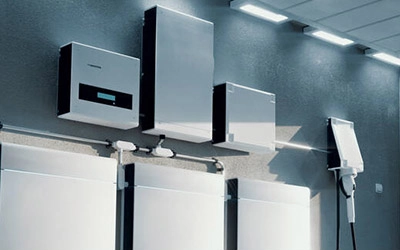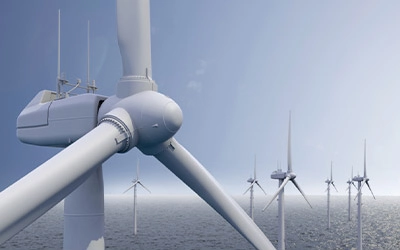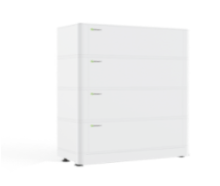Create a green future with an
Energy storage solution
Our configurable integrated battery management solution enables your organization to select the optimal battery and system components based on your needs, and start building battery energy storage solution of any scale and capacity. We also offer power engineering design, manufacturing, and software development services to assist you in completing your projects.
Benefits of Energy Storage Solution

Increased Load Balancing
Energy storage system can achieve load balancing by accumulating surplus energy during periods of low demand and discharging the stored energy during times of peak demand.

Support For Renewable Energy
Energy storage can assist in mitigating the variability of renewable energy sources by storing surplus energy generated during periods of high generation and discharging it during periods of low generation.

Reduced Carbon Emissions
Energy storage system can reduce carbon emissions by increasing the use of renewable energy and reducing reliance on fossil fuels.

Improved Grid Stability
Battery energy storage solution can provide backup power to the grid during power outages, improving grid stability and resilience.

Cost Savings
By utilizing stored energy during times of peak demand and avoiding higher electricity prices, energy storage can effectively lower electricity bills.

Extended Battery Life
Solar energy storage can extend the life of batteries by maintaining a consistent charge and discharge cycle, resulting in longer battery life.
Energy Storage Solution System Diagram
Energy storage solutions include a complete set of "energy storage inverter + battery" solutions, with multiple solar energy storage inverters and battery management systems, suitable for new solar energy storage power stations, retrofitting existing grid-connected systems or areas without (weak) power grids. Our solar energy storage system enable higher self-consumption of green energy, reduce electricity expenses, and ensure critical equipment remains powered during outages. Users can easily monitor power station performance through our cloud monitoring system and enjoy a zero-carbon lifestyle.
Energy Storage Solution System Diagram

Where Can The Energy Storage Solution Be Used?
- Business
- Transportation
- Building
- Agriculture
- Residential
- Electric vehicles
- Communication
- Grid
Business
Energy storage technology can provide additional power support during peak load periods and provide emergency power supply during power outages.

Transportation
Energy storage solutions can be used to support the operation of electric vehicles, such as power reserves for fast charging stations and power reserves for public transport vehicles.

Building
Energy storage solutions can be used for building energy conservation and lighting control, as well as providing backup power to ensure the normal operation of buildings.

Agriculture
Energy storage solutions can be used to provide power supply for irrigation and greenhouse facilities in agricultural production, improving efficiency and reliability.

Residential
Energy storage technology can be used in residential settings to store excess solar energy for later use, reducing reliance on the grid and lowering energy costs. In addition, they can serve as a backup power source during power outages.

Electric vehicles
Energy storage technology is an essential component of electric vehicles, providing the necessary power to drive the vehicle and storing energy during braking.

Communication
Energy storage technology can be used to provide backup power for communication infrastructure, ensuring the normal operation of critical communication facilities during power outages.

Grid
Energy storage technology can provide a range of grid services, such as frequency regulation, voltage support, and peak shaving, helping to maintain grid stability and reliability.









Our Energy Storage Solution Is Better Than Others

Flexible
Versatile and widely applicable PCS;
Modular design of battery modules, supporting parallel connection and easy system expansion;
Supporting various operation modes, including self-use, time-sharing and backup modes.

Efficient
High-efficiency power conversion;
Rapid response to commands.

Safe and Reliable
Sufficient electrical protection and multi-state monitoring;
Universal and certified PCS and container/cabinet systems;
IP65 protection level to ensure efficient system operation;
Control different power responses based on different;
battery SOC to extend battery life by 20%.
Engineering design and manufacturing of energy storage solutions Turnkey development of energy storage solutions

Design Review
Technical review of your energy storage system design or RFP.

Quality Control
Focus on regulatory certified system designs (e.g. UL 1973, UL 9540, CE, CISPR, FCC, etc.).

Flexible Customization
Customize energy storage solutions based on different power, capacity, charging and discharging rates, operating time, application scenarios, as well as application environments and requirements.

Manufacturing
Processing and assembly of materials, including battery pack assembly, mechanical structure processing, electronic component welding and installation, etc.

Selection and Procurement
Prepare materials for energy storage equipment and components according to the design plan, including batteries, inverters, electronic components, mechanical parts, etc.

System Debugging
Debug and test the installed energy storage system, including performance, safety, reliability testing, and verification.

Operation and Maintenance
The operation and maintenance of the energy storage system is an important part of the energy storage project design, including operation monitoring, fault diagnosis, and maintenance.

Software Integration
User interface and application-level software and network solutions, enabling system monitoring, management, and maintenance.

Packaging and Shipping
Package and label the manufactured energy storage equipment and components, and ship according to contract requirements.
FAQs of Energy storage solution
An energy storage system is a technology designed to store electrical energy and utilize it at a later time.
Energy storage systems can provide many benefits, including reducing energy costs, improving grid stability, increasing energy efficiency, and enhancing energy security.
There are several types of energy storage systems, including batteries, pumped hydro storage, compressed air energy storage, flywheels, and thermal energy storage.
A battery management system (BMS) is a system that oversees and tracks the operation of a battery. It comprises sensors, control electronics, and software that oversee the battery’s charging and discharging, temperature, and voltage regulation.
The longevity of an energy storage system is influenced by various factors, such as the type of technology employed, the operational environment, and the maintenance procedures. Certain battery technologies have a lifespan of 10-15 years or more.
A microgrid refers to a small-scale power grid that can function autonomously, separate from the primary electrical grid. Typically, it is composed of various distributed energy resources like energy storage systems and renewable energy sources.
A grid-tied energy storage system is connected to the electrical grid and can feed surplus energy back into the grid, whereas an off-grid energy storage system operates autonomously and is commonly employed in remote areas or as a backup power source.
Energy storage can help to reduce carbon emissions by increasing the penetration of renewable energy sources, reducing the need for fossil fuel-based power plants, and improving the efficiency of the overall energy system. Furthermore, it can aid in lowering the air pollution and water usage related to energy generation.



